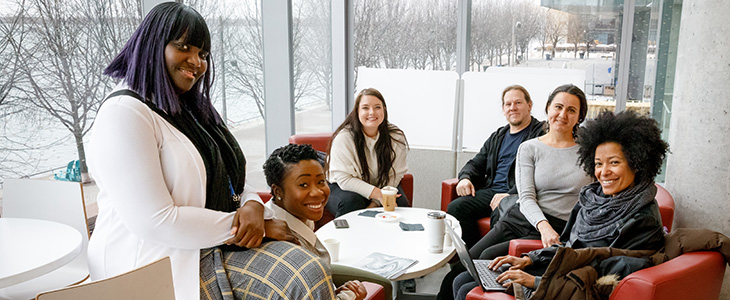1
Get Started with Onboarding
Get Started with Onboarding

What Is Onboarding?
Onboarding is the practice of introducing a new employee to the organization and providing them with the appropriate tools, resources, and knowledge to be successful and productive in a new role. Onboarding begins at the acceptance of the employment offer and continues through the first year. Research shows that organizations with effective onboarding processes are effective at:
- Reducing the time for new employees to become productive.
- Boosting the engagement of new employees.
- Improving the retention of new employees.
- Enhancing the organization’s reputation as an employer.
A great onboarding experience adds value beyond just effectiveness. Preparing for onboarding and providing a great experience can also help make new employees feel like they are entering a workspace that is psychologically safe. It builds engagement and connection to our community here at George Brown College. It’s also part of our promise as a great place to work.
Roles And Responsibilities
Onboarding at George Brown College is a shared responsibility between managers, new employees, and College departments, such as People and Culture. The role and responsibilities for each are listed below.
The Role of The Manager
- Drives the onboarding experience of a new employee.
- Creates and fosters a relationship with a new employee.
The Role of The New Employee
- With guidance from manager, self-directs to complete onboarding tasks and learnings.
- Asks questions and actively seeks out information and clarification as needed.
The Role of People and Culture
- Provides support and resources to managers and new employees to facilitate a successful onboarding experience.
- Monitors for feedback on the onboarding experience for continuous improvement.
Onboarding Buddy System
The buddy system is an excellent tool to support new employees and create a positive onboarding experience. A buddy system is where a new employee is paired with a more tenured employee at the same or similar level, to help them acclimatize to the role. The buddy’s role is to give advice, answer questions, and introduce the new employee. It offers the opportunity for a peer to take on a role in onboarding, and acts as a friendly point of contact to help new employees adjust to their role.
What Does A Great Buddy System Look Like?
- It helps the new employee acclimate: A great buddy can show the new employee how to find their way around, including where to find resources or how to use technology.
- It pairs peers: A buddy is a peer to the new employee and is not responsible for their performance or approving their actions. A buddy does not replace the role of a manager, or direct reporting relationship.
- It’s a secondary way to ask questions: The buddy system allows an employee a second person to ask questions.
- It supports socialization: The buddy system helps to form connections between the new employee, their team, and other key contacts.
- It supports knowledge transfer: Buddies can share personal experiences, share knowledge, and teach necessary skills.
- It's participatory: The buddy system offers a more casual setting for a new employee to connect with team members. It’s recommended to set up buddies to meet weekly for the first month. From there, encourage flexibility between buddies after the first month.
Required Training
At GBC, required training is something we must do as new and existing employees. Employees will be automatically assigned required training modules and can access them by logging into Cornerstone. As a manager, be sure to plan and support employees to complete the required training throughout their onboarding.
Required Training at GBC
New employees will be assigned required training as they join GBC, based on their role. Below is a non-exhaustive list of required training that may be assigned:
- AODA Customer Service Standard
- AODA Employment Standard
- AODA General Requirements
- AODA Information and Communication Standard
- Doing the Work: An Introduction to Anti-Racism
- Occupational Health and Safety Awareness for Supervisors in 5 Steps
- Occupational Health and Safety Awareness for Workers in 4 Steps
- Respect in the Workplace: Workplace Violence and Harassment Prevention for Employees or Respect in the Workplace: Workplace Violence and Harassment Prevention for Supervisors
- WHIMIS 2015
- Working Together: The Code and the AODA
The Onboarding Journey
The onboarding journey spans from before the new employee starts, all the way to the first year. There are lots of activities and experiences that make up the employee's experience as they onboard. The next modules in this toolkit are grouped around the key phases of onboarding and will provide the actions managers and employees need to take at each step.
